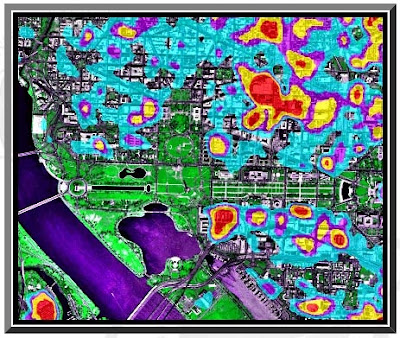 Research from the Lawrence Berkeley National Laboratory (LBL) indicates that they definitely are. In partnership with the EPA, LBL has studied the ability of urban materials to reflect light and absorb heat. The above graphic is of Washington, D.C. and the hot colors indicate the heated locations. Some of this research was co-authored by the current Secretary of Energy Steven Chu before taking his current post.
Research from the Lawrence Berkeley National Laboratory (LBL) indicates that they definitely are. In partnership with the EPA, LBL has studied the ability of urban materials to reflect light and absorb heat. The above graphic is of Washington, D.C. and the hot colors indicate the heated locations. Some of this research was co-authored by the current Secretary of Energy Steven Chu before taking his current post.In general the phenomenon is referred to as the “urban heat island.” Interestingly, as asphalt ages and goes from black to gray, the ability of pavement to heat up decreases, as seen in the graph below. That’s just about the time when a new application of coal tar sealants is applied to return it to a heat absorbing, deep black color.
Just how different is coal tar sealant from others in its ability to heat up a city? Some research in Austin by a PhD student (Mohan Rao) at Texas State University looked at the reflectivity of coal tar and asphalt-based sealants, but it did not cover the full spectrum of light that can produce heat as shown in the graph below. The reflectivity is affected by a material’s properties in both the visible and invisible spectrums. I have noticed some asphalt-based sealants are as much as 10 to 15 degrees F cooler than coal tar, but that is expected to vary from product type (asphalt, coal tar, acrylic, or gilsonite) and with the numerous amounts of filler used to blacken a sealant.
So how significant is this heating? Dr. Chu states that appropriate cooling of urban impervious surfaces, roofs and pavement, would be the equivalent of removing the carbon emissions of all of the cars in the world for 11 years! In Austin, Texas just reducing the sealant color from “new asphalt black” to aged gray, there is a measurable reduction in energy consumption by the 500,000 households there.
The cost of hotter cities is not just in the electric bill either. It also increases the production of lung-damaging ozone, which in turn can cost not only health care and productivity costs, but also compliance costs and jobs.
As you can see below the pavement percentage of a city is different across the US, but it is about double the surface area of rooftops. With the frequency of sealant application much more often than roof replacement, doesn’t it make sense to know which non-toxic products reduce our urban pavement furnaces?




